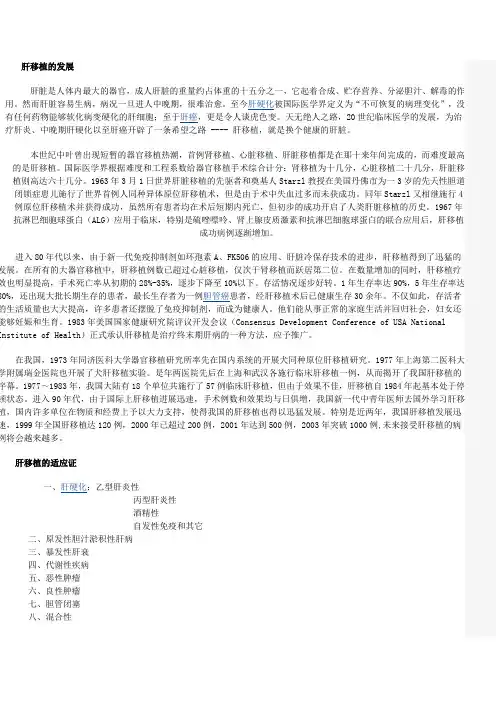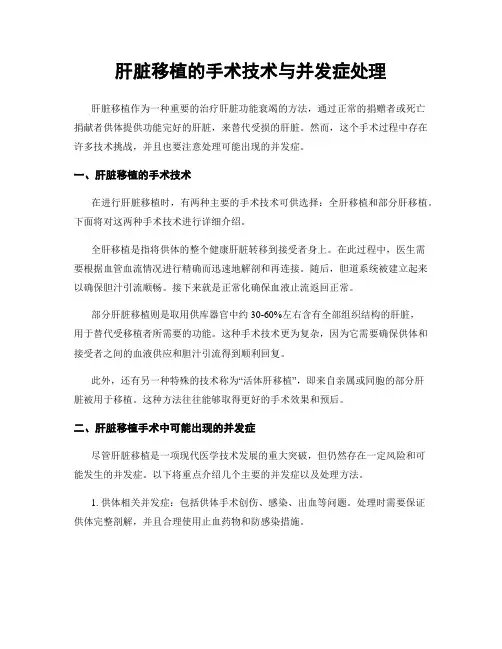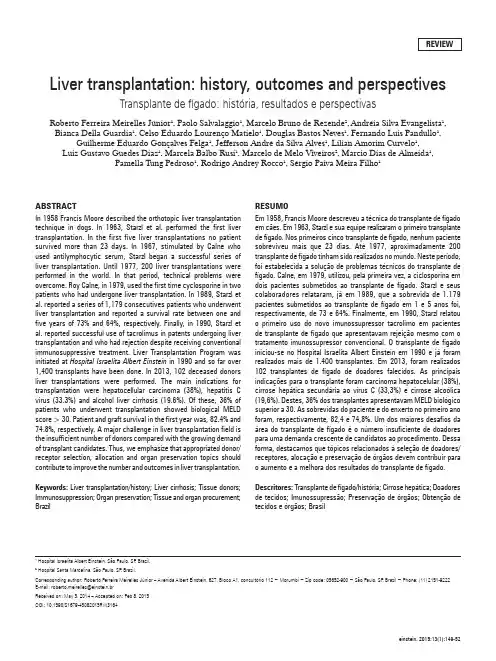《肝脏移植》综述
- 格式:docx
- 大小:22.88 KB
- 文档页数:5




肝移植的发展肝脏是人体内最大的器官,成人肝脏的重量约占体重的十五分之一,它起着合成、贮存营养、分泌胆汁、解毒的作用。
然而肝脏容易生病,病况一旦进人中晚期,很难治愈。
至今肝硬化被国际医学界定义为“不可恢复的病理变化”,没有任何药物能够软化病变硬化的肝细胞;至于肝癌,更是令人谈虎色变。
天无绝人之路,20世纪临床医学的发展,为治疗肝炎、中晚期肝硬化以至肝癌开辟了一条希望之路 ---- 肝移植,就是换个健康的肝脏。
本世纪中叶曾出现短暂的器官移植热潮,首例肾移植、心脏移植、肝脏移植都是在那十来年间完成的,而难度最高的是肝移植。
国际医学界根据难度和工程系数给器官移植手术综合计分:肾移植为十几分,心脏移植二十几分,肝脏移植则高达六十几分。
1963年3月1日世界肝脏移植的先驱者和奠基人Starzl教授在美国丹佛市为一3岁的先天性胆道闭锁症患儿施行了世界首例人同种异体原位肝移植术,但是由于术中失血过多而未获成功。
同年Starzl又相继施行4例原位肝移植术并获得成功,虽然所有患者均在术后短期内死亡,但初步的成功开启了人类肝脏移植的历史。
1967年抗淋巴细胞球蛋白(ALG)应用于临床,特别是硫唑嘌呤、肾上腺皮质激素和抗淋巴细胞球蛋白的联合应用后,肝移植成功病例逐渐增加。
进入80年代以来,由于新一代免疫抑制剂如环孢素A、FK506的应用、肝脏冷保存技术的进步,肝移植得到了迅猛的发展。
在所有的大器官移植中,肝移植例数已超过心脏移植,仅次于肾移植而跃居第二位。
在数量增加的同时,肝移植疗效也明显提高,手术死亡率从初期的28%-35%,逐步下降至10%以下。
存活情况逐步好转。
1年生存率达90%,5年生存率达80%,还出现大批长期生存的患者,最长生存者为一例胆管癌患者,经肝移植术后已健康生存30余年。
不仅如此,存活者的生活质量也大大提高,许多患者还摆脱了免疫抑制剂,而成为健康人。
他们能从事正常的家庭生活并回归社会,妇女还能够妊娠和生育。

肝脏移植的手术技术与并发症处理肝脏移植作为一种重要的治疗肝脏功能衰竭的方法,通过正常的捐赠者或死亡捐献者供体提供功能完好的肝脏,来替代受损的肝脏。
然而,这个手术过程中存在许多技术挑战,并且也要注意处理可能出现的并发症。
一、肝脏移植的手术技术在进行肝脏移植时,有两种主要的手术技术可供选择:全肝移植和部分肝移植。
下面将对这两种手术技术进行详细介绍。
全肝移植是指将供体的整个健康肝脏转移到接受者身上。
在此过程中,医生需要根据血管血流情况进行精确而迅速地解剖和再连接。
随后,胆道系统被建立起来以确保胆汁引流顺畅。
接下来就是正常化确保血液止流返回正常。
部分肝脏移植则是取用供库器官中约30-60%左右含有全部组织结构的肝脏,用于替代受移植者所需要的功能。
这种手术技术更为复杂,因为它需要确保供体和接受者之间的血液供应和胆汁引流得到顺利回复。
此外,还有另一种特殊的技术称为“活体肝移植”,即来自亲属或同胞的部分肝脏被用于移植。
这种方法往往能够取得更好的手术效果和预后。
二、肝脏移植手术中可能出现的并发症尽管肝脏移植是一项现代医学技术发展的重大突破,但仍然存在一定风险和可能发生的并发症。
以下将重点介绍几个主要的并发症以及处理方法。
1. 供体相关并发症:包括供体手术创伤、感染、出血等问题。
处理时需要保证供体完整剖解,并且合理使用止血药物和防感染措施。
2. 受体相关并发症:由于免疫抑制剂使用以及器官排斥反应等原因,受体在移植后可能面临感染、排斥反应、移植后肿瘤等问题。
处理时需要详细评估患者的免疫状态,并采取相应的治疗药物,如抗感染药物和免疫抑制剂。
3. 器官功能障碍:术后可能出现肝脏功能障碍,包括原发性肝功能衰竭等。
这通常需要危重监护和插管治疗,以确保患者尽快恢复正常功能。
4. 冠脉供血不足:术中或术后可引起冠脉血液供应不足,可能导致心肌缺血和心肌损伤。
处理此类并发症时应考虑相应的冠脉介入手术或药物干预。
5. 血管并发症:在手术过程中可能出现肝门静脉或下腔静脉狭窄、闭塞等问题。




einstein. 2015;13(1):149-52REVIEwLiver transplantation: history, outcomes and perspectivesTransplante de fígado: história, resultados e perspectivasRoberto Ferreira Meirelles Júnior 1, Paolo Salvalaggio 1, Marcelo Bruno de Rezende 2, Andréia Silva Evangelista 1, Bianca Della Guardia 1, Celso Eduardo Lourenço Matielo 1, Douglas Bastos Neves 1, Fernando Luis Pandullo 1,Guilherme Eduardo Gonçalves Felga 1, Jefferson André da Silva Alves 1, Lilian Amorim Curvelo 1, Luiz Gustavo Guedes Diaz 1, Marcela Balbo Rusi 1, Marcelo de Melo Viveiros 2, Marcio Dias de Almeida 1,Pamella T ung Pedroso 1, Rodrigo Andrey Rocco 1, Sérgio Paiva Meira Filho 11 Hospital Israelita Albert Einstein, São Paulo, SP , Brazil.2Hospital Santa Marcelina, São Paulo, SP , Brazil.Corresponding author: Roberto Ferreira Meirelles Júnior – Avenida Albert Einstein, 627, Bloco A1, consultório 112 − Morumbi − Zip code: 05652-900 − São Paulo, SP , Brazil − Phone: (11) 2151-9222E-mail: roberto.meirelles@einstein.brReceived on: May 5, 2014 – Accepted on: Feb 8, 2015DOI: 10.1590/S1679-45082015RW3164ABSTRACTIn 1958 Francis Moore described the orthotopic liver transplantation technique in dogs. In 1963, Starzl et al. performed the first liver transplantation. In the first five liver transplantations no patient survived more than 23 days. In 1967, stimulated by Calne who used antilymphocytic serum, Starzl began a successful series of liver transplantation. Until 1977, 200 liver transplantations were performed in the world. In that period, technical problems were overcome. Roy Calne, in 1979, used the first time cyclosporine in two patients who had undergone liver transplantation. In 1989, Starzl et al. reported a series of 1,179 consecutives patients who underwent liver transplantation and reported a survival rate between one and five years of 73% and 64%, respectively. Finally, in 1990, Starzl et al. reported successful use of tacrolimus in patents undergoing liver transplantation and who had rejection despite receiving conventional immunosuppressive treatment. Liver Transplantation Program was initiated at Hospital Israelita Albert Einstein in 1990 and so far over 1,400 transplants have been done. In 2013, 102 deceased donors liver transplantations were performed. The main indications for transplantation were hepatocellular carcinoma (38%), hepatitis C virus (33.3%) and alcohol liver cirrhosis (19.6%). Of these, 36% of patients who underwent transplantation showed biological MELD score > 30. Patient and graft survival in the first year was, 82.4% and 74.8%, respectively. A major challenge in liver transplantation field is the insufficient number of donors compared with the growing demand of transplant candidates. Thus, we emphasize that appropriated donor/receptor selection, allocation and organ preservation topics should contribute to improve the number and outcomes in liver transplantation.Keywords: Liver transplantation/history; Liver cirrhosis; Tissue donors; Immunosuppression; Organ preservation; Tissue and organ procurement; BrazilRESUMOEm 1958, Francis Moore descreveu a técnica do transplante de fígado em cães. Em 1963, Starzl e sua equipe realizaram o primeiro transplante de fígado. Nos primeiros cinco transplante de fígado, nenhum paciente sobreviveu mais que 23 dias. Até 1977, aproximadamente 200 transplante de fígado tinham sido realizados no mundo. Neste período, foi estabelecida a solução de problemas técnicos do transplante de fígado. Calne, em 1979, utilizou, pela primeira vez, a ciclosporina em dois pacientes submetidos ao transplante de fígado. Starzl e seus colaboradores relataram, já em 1989, que a sobrevida de 1.179 pacientes submetidos ao transplante de fígado em 1 e 5 anos foi, respectivamente, de 73 e 64%. Finalmente, em 1990, Starzl relatou o primeiro uso do novo imunossupressor tacrolimo em pacientes de transplante de fígado que apresentavam rejeição mesmo com o tratamento imunossupressor convencional. O transplante de fígado iniciou-se no Hospital Israelita Albert Einstein em 1990 e já foram realizados mais de 1.400 transplantes. Em 2013, foram realizados 102 transplantes de fígado de doadores falecidos. As principais indicações para o transplante foram carcinoma hepatocelular (38%), cirrose hepática secundária ao vírus C (33,3%) e cirrose alcoólica (19,6%). Destes, 36% dos transplantes apresentavam MELD biológico superior a 30. As sobrevidas do paciente e do enxerto no primeiro ano foram, respectivamente, 82,4 e 74,8%. Um dos maiores desafios da área do transplante de fígado é o número insuficiente de doadores para uma demanda crescente de candidatos ao procedimento. Dessa forma, destacamos que tópicos relacionados à seleção de doadores/receptores, alocação e preservação de órgãos devem contribuir para o aumento e a melhora dos resultados do transplante de fígado.Descritores: Transplante de fígado/história; Cirrose hepática; Doadores de tecidos; Imunossupressão; Preservação de órgãos; Obtenção de tecidos e órgãos; Brasil150Meirelles Júnior RF, Salvalaggio P, Rezende MB,Evangelista AS, Guardia BD, Matielo CE, Neves DB, Pandullo FL, Felga GE, Alves JA, Curvelo LA, Diaz LG, Rusi MB, Viveiros MM, Almeida MD, Pedroso PT, Rocco RA, Meira Filho SPINTRODUCTIONLiver transplantation is the treatment of choice for patients with cirrhosis, decompensated disease, acute liver failure and hepatocellular cancer within Milan criteria.(1)This study briefly reviews history, and shows recent results of liver transplantation in Brazil and around the world, as well as controversial topics and perceptives in this subject.HISTORY OF LIVER TRANSPLANTATIONIn 1955, Welch was the first to describe scientifically the liver transplantation as a treatment. In that time, he proposed an ectopic liver transplantation in abdominal cavity.(2) In 1958, Francis Moore described the first orthotopic liver transplantation in dogs.(3)In March 1st 1963, Starzl et al. did the first liver transplantation in the world. The patient was an 3-year-old boy with biliary atresia who underwent liver transplantation, however, he died during the surgery because of coagulation disorder and uncontrolled bleeding.(4) First, all liver transplant patients received immunosuprresion proposed for kidney transplantation, i.e., azathioprine and corticoids. Hence, results were discouraging. No patient have survived more than 23 days in the first 5 liver transplantation performed.(4) Ischemia-reperfusion injury and rejection inevitably progressed to liver failure or sepsis.Discoraging and recognizing the large difficults posed for liver transplantation, Starzl progressively developed procedures and principles that guide liver transplantation to date. In 1967, stimulated by Calne to use anti-thymocyte globulin, Starzl successfully performed several liver transplantations at the University of Colorado. The first case was a patient with advanced hepatocelular cancer who survived more than 1 year with preserved liver function and died due to the disease recurrence.(5)Because of the relative success and improve of initial survival, 70% of deaths were common in most of liver transplantation services. The non-selective immunosuppression scheme associated with the surgical complexity of liver transplantation lead patients to become extremely vulnerable to infections.Infection complications and chronic rejection in liver transplantation were the main cause of early and late deaths, respectively. Hence, better immunosuppresses and anti-infection agents. Until 1997, roughly 200 transplantations have been done in the world. In this period, technical problems of biliary reconstruction, intraoperative coagulopathy treatment and surgical technical of donor were stated.(6) In the following 15 years only the University of Colorado and Cambridge University conducted experimental clinical studies in liver transplantation.(7)In 1979, Calne used for the first time the cyclosporine in two patients who had undergone liver transplantation launching a new step in history of liver transplantation.(8) In 1983, the National Institutes of Health, after evaluate the result of 531 cases, approved liver transplantation as a valid therapy for treament of end-stage liver diseases.In 1989, Starzl et al. reported survival of 1,179 patients submitted to liver transplantation from 1 to 5 years after the procedure (73% and 64%, respectively). These results corresponded to double the survival of patients who used azathioprine and corticoids.(9) Finally, in 1990, Starzl et al. reported the first use of the new tacrolimus as imunosupressant agent in patients submitted to liver transplantation who suffered a rejection even using conventional immunosuppressive treatment. The success of cyclosporine conversion by tracrolimus in these patients and by showing it safety, new clinical studies were conducted using tacrolimus as the main immunosuppressor in liver transplantation.(10-12) Currently, more than 40 years from the first liver transplantation, more than 10.000,00 liver transplantations have been performed in the world so far. Liver transplant patients’ survival within the first year is roughly 80% to 90%. A progressive improve in results, surgical problems, rejection treatment and untreated sepsis control were resolved.(10) However, the number of patients in waiting list for liver transplantation has progressively increased compared with the number of deceased donors. However, there is the need of better access for patients to transplantation center, progresses in organization and improvements in transplantation system, filter in indications and better use of donations made. GENERAL OVERVIEw OF LIVER TRANSPLANTATION IN BRAZILIn 1968, Machado et al. performed the first liver transplantation at Hospital das Clínicas da Faculdade de Medicina da Universidade de São Paulo (HC-FMUSP). Their patient had survived for 7 days, but he developed infection and acute allograft rejection.(13) In 1969 and 1971 other two patients were submitted to liver transplantation and survival was, respectively, 18 and 30 days. In 1985 Silvano Raia restart liver transplantation in Brazil at HC-FMUSP and 1988, Raia et al. performed the first living donor transplation in the world.(14) In the last decades an expressive increase in number of transplantation teams in Brazil have been seen. Theseeinstein. 2015;13(1):149-52151Liver transplantation: history, results and perspectives einstein. 2015;13(1):149-52teams are more concentrated in South and Southeast region. The Brazil Public health System is responsible for more than 95% of liver transplantations done in the country, and it provides universal access to treatment, and even immunosuppressant agents for patients. Brazil has become the world’s largest public system of transplantation and the third in world when it comes to liver transplantation. The population’s awareness about organs and tissues transplantation and identification of potential donor by health professional have been improved so far. The number of donations in Brazil has reached an unprecedented number of 13.2 per million inhabitants. In the last 2 years, Brazil Federal Government has successfully increase and promote the decentralization of transplantation teams in the country. Such actions must continue to increase the transplants in Brazil and place the country as world leader in liver transplantation.LIVER TRANSPLANTATION AT HOSPITAL ISRAELITA ALBERT EINSTEINLiver transplantation at Hospital Israelita Albert Einstein (HIAE) began in 1990. So far, the hospital liver transplantation program has done more than 1,400 transplants. Of these, 95% were patients referred from Brazil Public Health System. These patients have complete access to the hospital’s infrastructure, resources and medical team without any cost.In 2013, a total of 102 adult deceased donor liver transplantations were performed. Main reasons for transplantation were hepatocellular cancer (38%), liver cirrhosis due to hepatitis C virus (33.3%), and alcoholic cirrhosis (19.6%). Other indications were cryptogenic cirrhosis (9.8%) fatty liver (19.6%) and acute liver failure (5.8%). Of these, 36% of transplants had MELD score > 30. Indexes of primary allograft non-function, hepatic artery thrombosis and early mortality were 7.8%, 1.9% and 9.8%, respectively. Survival of patients, first, third and fifth allografts are presented in table 1 and 2. Figures 1 and 2 describe survival curves of patient and allograft compared with liver transplantation services in São Paulo State.Table 2. Allografts survival in first, third and fifth year after liver transplantation from January 1st 2006 and December 31st 2013Post-transplantation period São Paulo State(%)HIAE (%)UNOS (%)1 year 65.374.885.23 years 60.368.275.15 years57.463.468.5Sources: Secretaria de Estado da Saúde de São Paulo and UNOS.HIAE: Hospital Israelita Albert Einstein ; UNOS:United National Organ Sharing.Figure 1. Actuarial survival curve. Kaplan-Meier of patients who underwent liver transplantation at Hospital Israelita Albert Einstein (n=748) and at other liver transplantation services in São Paulo State (n=3.738) from January 2006 andDecember 2013Figure 2. Actuarial survival curve. Kaplan-Meier of patients who receivedhepatic allografts at Hospital Israelita Albert Einstein (n=858) and at other liver transplantation services in São Paulo State (n=4.075) from January 2006 and December 2013Table 1. Patients survival in first, third and fifth year after liver transplantation from January 1st 2006 and December 31st 2013Post-transplantation period São Paulo State(%)HIAE (%)UNOS (%)1 year 69.482.489.73 years 65.177.3815 years62.674.374.3Source: Secretaria de Estado da Saúde de São Paulo and UNOS.HIAE: Hospital Israelita Albert Einstein ; UNOS : United National Organ Sharing.CURRENT INTERESTING TOPICS AND PERSPECTIVES One of the biggest challenges of liver transplantation area is the insufficient number of donors compared with the growing demand of transplant candidates.152Meirelles Júnior RF, Salvalaggio P, Rezende MB,Evangelista AS, Guardia BD, Matielo CE, Neves DB, Pandullo FL, Felga GE, Alves JA, Curvelo LA, Diaz LG, Rusi MB, Viveiros MM, Almeida MD, Pedroso PT, Rocco RA, Meira Filho SPTherefore, we highlight the related-topics to donor/ recipient selection, allocation and organ preservation must contribute for the improvement of results in liver transplantation.The use of xenotransplantation, mainly by the use of genetically modified pigs as well as bioengineering by creation of synthetic liver in the laboratory can change dramatically the allografts paucity.(15) However, until we reach this next level, news strategies must focus in provision of the maximal use of hepatic allografts in Brazil. Perhaps, the use of allografts, otherwise discarded, can be possible by using pharmacological or mechanical strategies. Among these strategies, we must emphasize the recent development of perfusion devices that seem to modulate very interesting the ischemic-reperfusion injury.(16,17)The possible use of living donors must be considered. The indication and modern techniques arising have contributed for this alternative use and consequently increase of the number of patients’ benefit by transplantation.In São Paulo State, we have observed that scarcity of organs forces transplantation services to treat extremely ill patients. The discussion of uselessness, limits for indications in this scenario and adjusts for MELD score system must emphasize during scientific meetings.(18) Finally, we used Milan criteria for patients with hepatocellular cancer in order to provide them the chance to perform the transplantation. However, several evidences exist that some patients, which overcome Milan criteria, can be also benefit by transplantation.(19,20) In the future, new markers that will help to better select such patients, mainly with the use of genetic sequencing, must be developed. Finally, the discussion of allocation criteria for this population will continue to be a present topic in our scientific meetings.CONCLUSIONDespite the progressive improve in results because of the evolution of surgical technique, immunosuppression, treatment of rejection and infection, the challenging of treating patients who need liver transplantation remains as the single therapeutic option. The continuous practice of excellence in the treatment and the constant search to improve results must guide the future in liver transplantation. REFERENCES1. Fox AN, Brown RS Jr. Is the patient a candidate for liver transplantation? ClinLiver Dis. 2012;16(2):435-48. Review.2. Welch CS. [Liver graft]. Maroc Medical. 1955;34(359):514-5. French.3. Moore FD, Smith LL, Burnap TK, Dallenbach FD, Dammin GJ, Gruber UF, et al.One-stage homotransplantation of the liver following total hepatectomy in dogs. Transplantation Bulletin. 1959;6(1):103-7.4. Starzl TE, Marchioro TL, Vonkaulla KN, Hermann G, Brittain RS, WaddellWR. Homotransplantation of the liver in humans. Surg Gynecol Obstet.1963;117:659-76.5. Starzl TE, Groth CG, Brettschneider L, Penn I, Fulginiti VA, Moon JB, et al. Orthotopichomotransplantation of the human liver. Ann Surg. 1968;168(3):392-415. 6. Starzl TE, Putnam CW, Koep LJ. Current status of liver transplantation. SouthMedical J. 1977;70(4):389-90.7. Starzl TE, Iwatsuki S, Klintmalm G, Schröter GP, Weil R 3rd, Koep LJ, et al. Livertransplantation, 1980, with particular reference to cyclosporin-A. Transplant Proc. 1981;13(1 Pt 1):281-5.8. Calne RY, Rolles K, White DJ, Thiru S, Evans DB, McMaster P, et al. CyclosporinA initially as the only immunosuppressant in 34 recipients of cadaveric organs:32 kidneys, 2 pancreases, and 2 livers. Lancet. 1979;2(8151):1033-6.9. Starzl TE, Todo S, Tzakis AG, Gordon RD, Makowka L, Stieber A, et al. Livertransplantation: an unfinished product. Transplant Proc. 1989;21(1 Pt 2):2197-200.10. Fung JJ, Todo S, Jain A, McCauley J, Alessiani M, Scotti C, et al. Conversionfrom cyclosporine to FK 506 in liver allograft recipients with cyclosporine-related complications. Transplant Proc. 1990;22(1):6-12.11. Fung JJ, Todo S, Tzakis A, Alessiani M, Abu-Elmagd K, Jain A, et al. Currentstatus of FK 506 in liver transplantation. Transplant Proc. 1991;23(3):1902-5.12. Todo S, Fung JJ, Demetris AJ, Jain A, Venkataramanan R, Starzl TE. Earlytrials with FK 506 as primary treatment in liver transplantation. Transplant Proc.1990;22(1):13-6.13. Bacchella T, Machado MC. The first clinical liver transplantation of Brazilrevisited. Transplant Proc. 2004;36(4):929-30.14. Raia S, Nery JR, Mies S. Liver transplantation from live donors. Lancet.1989;2(8661):497.15. Cooper DK, Hara H, Ezzelarab M, Bottino R, Trucco M, Phelps C, et al. Thepotential of genetically-engineered pigs in providing an alternative source of organs and cells for transplantation. J Biome Res. 2013;27(4):249-53. 16. op den Dries S, Karimian N, Sutton ME, Westerkamp AC, Nijsten MW, GouwAS, et al. Ex vivo normothermic machine perfusion and viability testing of discarded human donor livers. Am J Transplant. 2013;13(5):1327-35.17. Henry SD, Nachber E, Tulipan J, Stone J, Bae C, Reznik L, et al. Hypothermicmachine preservation reduces molecular markers of ischemia/reperfusion injury in human liver transplantation. Am J Transplant. 2012;12(9):2477-86.18. Salvalaggio P, Afonso RC, Pereira LA, Ferraz-Neto BH. The MELD system andliver transplant waiting-list mortality in developing countries: lessons learned from Sao Paulo, Brazil. Einstein. 2012;10(3):278-85. English.19. Mazzaferro V, Bhoori S, Sposito C, Bongini M, Langer M, Miceli R, et al. Milancriteria in liver transplantation for hepatocellular carcinoma: an evidence-based analysis of 15 years of experience. Liver Transpl. 2011;17 Suppl 2:S44-57. Review.20. Yao FY. Liver transplantation for hepatocellular carcinoma: beyond the Milancriteria. Am J Transplant. 2008;8(10):1982-9. Review.einstein. 2015;13(1):149-52。

第七章肝移植的现状与进展概况1955年Welc h和1956年Jack C anno n首先提出肝移植1960年Mo o re开始作了解情况31例狗的肝移植(4-12天/7例)。
1963年S tarzl首先应用于临床,为一先天性胆道闭锁的患儿施行了原位肝移植(O rtho to p ic L iver Transp lan tat io n,O LT x)。
由此而开辟了临床肝移植术的先河,揭开了人类肝移植之序幕。
几乎与此同时,英国的C alne也同样对肝移植作了很多的临床探索,作出了很大的贡献。
虽然手术技术得到解决,但由于当年免疫抑制仅局限在类固醇和硫唑嘌呤,故其手术效果仍不令人满意。
80年代初五年生存率仅为20%。
直到新一代药物环孢素A (C ycro sp o rin A)问世,手术适应症从肝脏恶性疾病转为良性终末期肝病,其手术效果大为改观。
目前手术死亡率低于6%,一年生存率达到85%-90%,五年生存率高达75%-85%,长期存活者最长30年,近半数病人术后可做部份或全日工作。
美国已有100多个移植中心开展临床肝移植。
以U n ivers it y o f P ittsb ur g h Med ical C enter(UP MC)为例。
其最多每年达到600多例。
目前美国约有 1.8万多病人在等待肝移植,而由于供体不足每年仅完成8000例, 致使很多终末期肝病患者得不到治疗而死亡。
在欧洲和澳洲,也有许多肝移植中心相继成立,大约以每年2000-3000例的速度前进。
在我国,最早行肝移植是在1977年由武汉医学院完成(1977-1983,无一例存活超过一年/57例)。
在80年代几乎处于停滞状态。
到了90年代至今已完成肝移植大约在1000多例,至今全国已有很多医院相继开展肝移植治疗终末期肝病。
全世界肝移植已超过100,000人次,每年约以8000-10000之速度递增。
一.肝移植的适应症和禁忌症理论上,一切肝病因常规的内外科疗法不能治愈,而预计在二年内可能出现无法避免的死亡或死亡并发症者,均可列入肝移植行列,等待肝移植。

肝移植工作总结
肝移植是一项复杂而又重要的手术,对于患有严重肝病的患者来说,这是他们
获得新生的唯一希望。
在过去的一年里,我们医院进行了多例成功的肝移植手术,让患者重获健康和生命。
首先,对于肝移植手术来说,患者的合适供体是至关重要的。
我们的团队通过
精心的筛选和评估,找到了一些合适的供体,为患者提供了新的肝脏。
在手术过程中,我们的外科团队精湛的技术和丰富的经验,确保了手术的成功进行。
同时,麻醉团队和护理团队也发挥了不可或缺的作用,为手术提供了全方位的支持。
其次,在术后的护理和康复阶段,我们的团队也给予了患者充分的关怀和支持。
我们的营养师和康复医生制定了科学的饮食和锻炼计划,帮助患者尽快康复。
同时,我们的心理医生也给予了患者心理上的支持,让他们在身体上和心理上都能得到全面的康复。
最后,我们的团队也在肝移植领域的科研工作上取得了一些进展。
我们的医生
和科研人员积极参与国际学术交流,学习最新的肝移植技术和理念,为我们的患者提供更好的治疗方案。
总的来说,我们医院的肝移植团队在过去一年里取得了一些令人鼓舞的成绩。
我们将继续努力,为更多的肝病患者带来新的希望和生机。
希望通过我们的努力,可以让更多的人重获新生。
外科手术技术中的肝脏移植技术肝脏移植技术是一种复杂而高风险的外科手术,用于治疗肝功能衰竭和肝癌等疾病。
这种手术技术的发展为许多绝症患者带来了新的生机和希望。
本文将介绍肝脏移植技术的原理、手术步骤以及术后护理等相关内容。
肝脏移植技术是将健康的肝脏从一个捐赠者体内取出,移植到另一个肝功能严重受损或衰竭的患者体内。
手术的成功与否取决于供体与受体之间的匹配度以及外科团队的技术水平。
在肝脏移植手术中,首先需要一位适合的供体。
捐赠者的肝脏可以来自活体或死亡捐献者。
活体捐献者一般是患者的亲属或者亲密朋友,因为需要进行大规模手术,这意味着捐赠者需要非常健康,并具备所需的肝脏功能和解剖结构。
而死亡捐献者的肝脏则来自被宣布死亡并同意捐赠器官的患者,其肝脏会在原有体内取出,然后移植到等待器官的患者体内。
肝脏移植手术中的一个重要步骤是保护供体和受体肝脏,以确保肝脏在整个手术过程中不会受到损伤。
在手术中,外科医生会先切开受体的腹部,并将受体的病态肝脏取出。
接着,捐赠者的肝脏会被移植到受体体内,并连接上肝动脉、门静脉、肝总管和肝静脉等重要血管。
这一过程需要精确的手术技巧和高级医疗设备的支持。
术后的护理也是肝脏移植手术成功的关键。
获得新肝脏的患者需要接受长期的免疫抑制剂治疗,以避免机体对移植器官出现排斥反应。
此外,患者还需要密切监测新肝脏的功能和排异反应的发生,以及合理调整抗排斥药物的剂量。
肝脏移植手术的成功率逐年提高,但仍然面临许多挑战。
其中之一是供体的短缺问题,由于移植手术的需求远大于供体数量,很多患者需要等待很长时间才能得到合适的肝脏移植。
同样,由于手术本身的高风险性,术后并发症的发生也是一个重要的问题,包括感染、出血、手术切口愈合困难等。
尽管存在一些困难和风险,肝脏移植技术对于一些患有终末期肝疾病的患者来说是他们唯一的生命线。
通过成功的肝脏移植,患者可以获得新的生机和健康,重拾生活的信心。
在未来,随着科技的不断进步和医疗手段的改进,肝脏移植技术有望取得更大的突破,帮助更多的人重获健康和幸福。
肝脏移植综述各种原因引起的肝脏疾病发展到晚期危及生命时,采用外科手术的方法,切除已经失去功能的病肝,然后把一个有生命活力的健康肝脏植入人体内,挽救濒危患者生命,这个过程就是肝移植。
肝移植术是治疗终末期肝病的重要技术,通过肝移植,可以使晚期肝病患者在绝境中重获新的生机。
一、肝脏移植发展背景:1、1963年Starzl研究组首次在临床成功地完成了正位肝移植术。
2、第一例活体肝移植则是在整整25年之后,即1988年12月8日巴西圣保罗医科大学的Raia医生完成。
3、1994年1月我国成功地施行了亚州地区首例异体部分肝移植术。
4、相对于日本、欧美国家,我国活体肝移植尚处于起步阶段(台湾、香港除外)。
1995年1月南京医科大学在日本专家指导下开展大陆第一例活体肝移植,患者生存12天。
1997年6月30日,第四军医大学西京医院在日本京都大学Tanaka教授指导下,完成一例父女之间的亲体肝移植,已经健康存活了9年多,也是国内存活时间最长的活体肝移植病人。
目前国内已经有数十家医院相继开展活体肝移植。
二、肝移植手术适应症肝移植最初是用来治疗那些终末期肝病的,例如肝昏迷、急性重症肝炎、肝坏死等。
随着临床工作的进一步开展,目前其适应症已十分广泛,一切肝病凡用目前治疗方法不能治愈和预计不久会发生肝功能衰竭、死亡的病例都是肝移植的适应症。
具体有两大类:即恶性肿瘤和终末期良性肝病。
对于肝恶性肿瘤是否需要进行肝移植,目前尚存在争议,但因其发生率高,故肝癌患者肝移植约占全部肝移植病例的30%。
有意思的是,目前存活最长的肝移植患者恰恰就是肝癌患者。
对于良性肝病,最常见的手术适应症为:肝豆状核变性;胆汁淤积性肝病;肝实质性疾病;代谢性疾病;非肝性门脉高压症;急性肝坏死肝功能衰竭。
三、对移植肝脏质量有严格要求,一般需满足下列条件:1、供肝健康,肝储备功能正常。
2、供肝切取技术准确,肝动脉、门静脉、肝静脉、3、术中供肝热缺血时间较短。
4、据受体手术进展,调整供肝切取术进度,尽量缩短肝冷保存时间。
5、合理的肝灌洗、修整和保存。
四、肝脏移植手术注意事项1、环境准备术前为患者准备单人房间,使病室清洁整齐,舒适和谐。
室温保持在18℃-22℃,湿度保持50%-60%,保持病室安静,使患者心情放松。
病室灯光使用柔和光线,设有窗帘和钟表,使患者在术前昼夜分明,妥善安排会客与休息时间。
加强病房的消毒工作,每日紫外线消毒2次,每次30分钟。
2、术前指导各种肝病晚期由于病情反复,经济方面的原因,以及患者对肝移植相关知识的缺乏,会有不同程度的焦虑、抑郁。
患者与医护人员建立强有力的信任关系,可以明显降低术后并发症。
所以针对患者的心理反应,护士应详细介绍移植手术的方法、目的、优点和成功病例,为患者提供有效的处理对策,使其在肝移植术前具有良好的情绪和精神准备。
具体内容:①向患者讲明术前检查的必要性及注意事项;血、尿常规、血液生化、CT、骨扫描、心脏血管彩超等检查,以了解术前状态和观察术后恢复情况。
②帮助患者了解肝脏移植术,肝移植术后的排异反应及感染的预防,以及服用免疫抑制剂的必要性,服药后产生产生的副作用等;③指导患者掌握深呼吸和有效咳嗽的技巧,要求患者达到复述的目的;④向患者介绍各种监护仪、导管及插管的作用及重要性,减少患者术后对监护病房的恐惧感。
3、肝移移植监测要求3.1 接待患者接到手术室通知患者返回ICU后,医师、护士要穿好隔离衣,在ICU等待。
准备好心电监护仪、呼吸机。
患者入监护病房后,取平卧位,迅速连接各种管道,如心电监护、呼吸机、动静脉插管及各种引流管,妥善固定各种导管,防止意外脱落。
将患者四肢用防护带固定于床缘,防止患者大幅度无意识活动。
呼唤患者观察是否清醒,检查输液通路,同时留血尿标本送检。
护士应详细阅读麻醉和手术记录,了解手术经过、麻醉方式、术中出血情况、液体的出入量、血液动力学参数以及术中发身发生的其他情况。
3.2体温监测由于长时间手术暴露,术中大量补液和低温肝脏复温等,患者刚入ICU时体表温度一般均低于35℃,应给予复温护理。
[10]室温保持在28℃,床单位使用电热毯,待体温上升到36℃后停止使用,输入液体管道加温,温度恒定在37℃。
在使用电热毯时注意防止烫伤,复温时温度不宜过高。
3.3呼吸监测患者术后需呼吸机辅助通气。
严密监测呼吸频率、节律、气道压、潮气量、血氧饱和度(SaO2)、血气分析情况。
鼓励患者深呼吸,有效咳嗽,定时翻身、拍背、雾化排痰。
若患者清醒后自主呼吸良好,气道内分泌物少,SaO2在95%以上,血气分析正常,应尽早拔除气管插管,给予持续低流量吸氧。
若患者SaO2持续低于95%,首先应检查呼吸机的连接情况,有无管道漏气;充分吸痰;床旁胸片检查肺部情况,排除肺不张、气胸等情况。
若患者SaO2持续低于80%,立即气管切开呼吸机辅助呼吸。
护理上应注意:根据麻醉苏醒程度与肌力情况,调节机械通气时间,密切观察SaO2变化;吸痰动作要轻柔,避免气管壁损伤,引起出血、感染。
3.4 血流动力学监测无创监测:采用监护仪监测心律及波形变化,可准确判断有无心律失常。
护士必须掌握心电图的基本知识。
有创血压监测:使用套管针穿刺挠动脉与换能器相接,提供可靠和持续的动脉血压数值。
每两小时肝素稀释液冲洗管道1次,以保证监测系统通畅、确保测压准确。
如测值波动大(超过20mmHg),可与无创血压对照。
血压过高时注意高血压脑病、心衰等并发症的发生,偏低时结合补液量、尿量等情况考虑是否血容量不足。
飘浮导管:使用飘浮导管经颈内静脉插入监测肺动脉压和中心静脉压,估计左右心室功能,区别心源性和非心源性肺水肿,为扩容等心血管治疗提供依据。
五、肝脏移植术后的并发症在器官移植当中,肝脏移植的并发症是比较多的。
在大脏器移植当中,目前认为肝脏移植最复杂的,就是因为肝脏血管多,肝脏移植复杂就复杂在刚才讲到一定要做原位移植,把病肝切掉,因为机体凝血的物质完全在肝脏里,在肝脏移植的病人常常凝血机制不好,常常会出现大出血,手术后出血多,需要大量的输血,肝脏相对于其他的移植并发症多一些,比如手术后出血不止,手术后有血管并发症,不学医的病人认为肝脏移植手术后排斥反应比较多,真正的肝脏移植难是难在手术,难在手术并发症多,肝脏是一个免疫特惠器官,肝脏移植手术后免疫排斥发生是最好控制的,甚至比肾脏移植发生率都低,而且即使发生了排斥反映也容易控制,这是一个次要的问题。
现在肝脏移植手术并发症最难处理的严重感染,这是第一位的,然后是手术并发症,比如手术后动脉狭窄,手术后的胆管并发症,胆管发生结石。
临床上对这些并发症,如感染、出血有等,很好预防的方法,现在很多药物非常有效,因为其他器官做移植的话,肝脏功能是好的,凝血机制都是好的,手术后风险要小得多,而肝脏移植的病人凝血物质合成少了,现在科技发展输血有很大的进展,有含有凝血物质的新鲜全血;有血小板、Ⅶ因子、冷沉淀等成分输血。
对于凝血机制不好的病人,可以通过大量的输血,病人输了四千毫升、五千毫升的血等于把血换了一遍,通过大量输新鲜血,改善病人凝血机制。
其次病人血小板降低了,把血小板输进来,其他的凝血物质低了,把它补进来了。
肝脏移植的并发症控制有了非常好的进步。
六、肝移移植术后注意事项1、出血观察肝移植手术时间长、创伤大,术后使用抗凝血药物,因此密切观察有无出血倾向至关重要。
出血可发生在移植术后任何阶段,但多数发生在早期,常见是腹腔出血和胃肠道出血,定期监测血常规、PT、KPTT。
观察腹腔内有无出血,伤口有无渗血,观察左右膈下及胃管、胆管引流管中引流物的量、色泽和性质,观察引流管有无扭曲、阻塞、负压不足。
如术后24~48h引流量较多,无明显原因腹部胀痛,尿量减少提示出血可能。
严密观察血压、心率、呼吸、肺动脉压、体温、尿量变化,维持心率在60-100次/分,血压维持在90-120/60-80mmHg,中心静脉压(CVP)维持在10mmHg以下,给予止血药物如立止血1ku肌肉注射1次/6小时,洛塞克注射剂40mg静推2次/日,必要时输血治疗。
并定时行腹部超声检查。
2 、肝动脉血栓及栓塞肝动脉血栓形成及栓塞多发于1周内,是最严重的并发症。
[13]肝动脉血栓可表现为肝区突发性疼痛,精神萎靡,高热、腹水、肝功能异常。
超声波检查肝动脉血流消失。
1周内静滴低分子右旋糖酐注射液250ml 1次/日,或3个月内口服肠溶阿斯匹林50mg 1次/日,使机体保持在低凝状态,防止动脉血栓形成。
若患者有发热、血清转氨酶升高、胆漏,应警惕肝动脉栓塞的可能。
术后1周定时行肝脏血管超声波检查。
由于抗凝治疗,机体处于低凝状态,容易发生血管穿刺部位渗血,注意保护血管穿刺点,在拔除动脉、静脉插管时加压包扎,防止出血。
注意调节输液速度,避免血管负担加重或血液粘稠度改变。
3、排斥反应的监测肝移植术后排斥反应有3种形式:超急性排斥,急性排斥,慢性排斥。
急性排斥为肝移植术后早期严重并发症。
多发生在术后第6-7天至第6周出现,在排除感染和外科因素的情况下,如突然出现体温升高,情绪波动(烦躁或萎靡),倦怠,乏力,肝区胀痛,胆汁量减少、稀薄、色淡、黄疸加深、肝酶谱急剧升高,肝功异常提示为排异。
一旦确诊应及时大剂量使用激素治疗,如甲基强地松龙500mg加入生理盐水100ml快速滴入3天,再循环用药5-6天,每日减少10mg,逐日减至维持量20mg。
每日抽血化验肝功能,并准确记录胆汁量。
4、管道护理管理好各种导管是护理好肝移植患者的重要环节之一。
术后一般放置胃管、T管、腹腔引流管、尿管、静脉留置管、有创监测管道等。
各管应保持通畅,按时更换无菌导管、引流袋,严格执行无菌操作。
观察引流管内液体量、性质,如短期内引流出大量血性液体、患者腹胀、血压持续性降低,则提示有活动性出血,通知医生及时处理。
观察T管内胆汁量,因为T管是反映肝脏功能的窗口,也是反映排斥反应的窗口,应防止脱落或引流管扭曲或引流物堵塞等原因影响胆汁引流。
正常胆汁颜色为较清的金黄色液体,放置时间过长可变为深绿色。
胆汁量锐减、色淡而稀薄,提示有肝移植的排斥,有供肝缺血性损伤坏死。
术后T管内无胆汁预示T管堵塞、肝动脉血栓或原发性肝脏无功能。
5、用药护理服用免疫抑制剂是肝移植术后预防和治疗排斥反应的必要方法,需终身应用,应在医生指导下合理使用。
现在常采用“新三联”(FK506、骁悉、甲基强的松龙或强的松)。
在患者服用过程中做到“三个”准确:药名准确,剂量准确,时间准确。
因为FK506是一种大环内脂类药物,[16]属脂溶性药物,可有效预防急性排斥反应的发生,作用比环孢素A强10-100倍,可受饮食影响,需空腹服用,所以餐前1小时或餐后2-3小时服用FK506。
服药期间严密监测FK506血药浓度,对指导合理用药减少毒副作用,具有重要的指导意义。